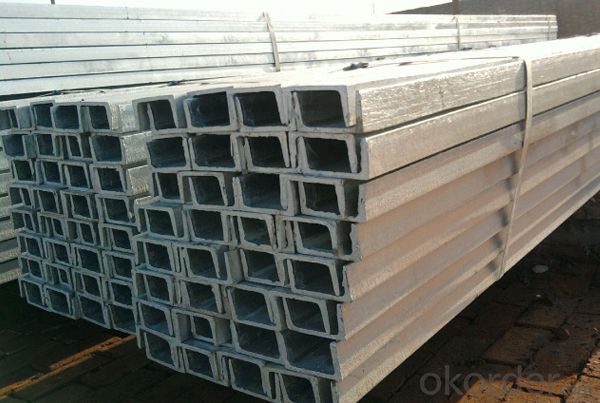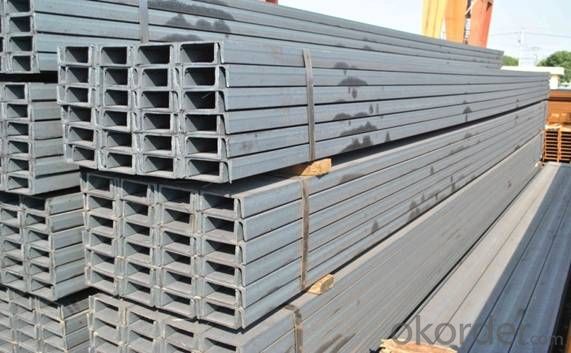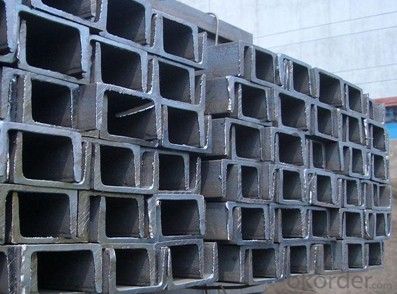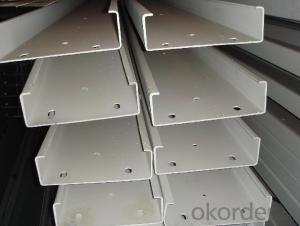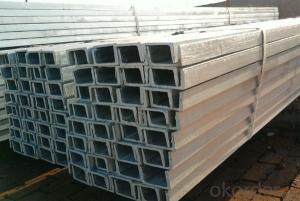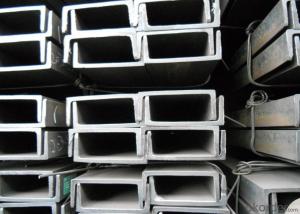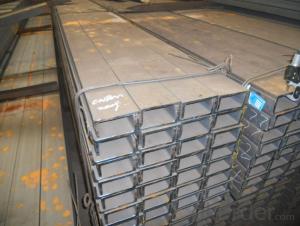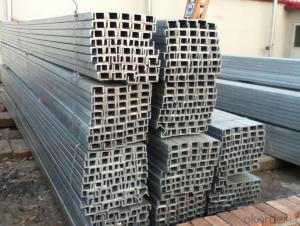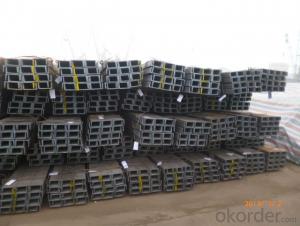High quality hot rolled JIS ou GB U CHANNEL
- Loading Port:
- Shanghai
- Payment Terms:
- TT OR LC
- Min Order Qty:
- 25 m.t.
- Supply Capability:
- 2000000 m.t./month
OKorder Service Pledge
OKorder Financial Service
You Might Also Like
U CHANNEL Details:
Product Description:
Specifications of MS Channel:
1.We supply high quality MS Channel at reasonable price, including Chinese standard, Japanese standard and so on.
Standard | GB/JIS |
Material Grade | Q235,SS400 |
Technique: | Hot Rolled |
Sizes as per chinese standard: | 50*37*4.5mm - 300*89*11.5mm |
Sizes as per japanese standard: | 50*25*3mm – 200*80*7.5mm |
Length: | 6meter, 9meter, 12meter |
Note: 1.we are also competent to provide our customers other MS Channel based on other sizes according to customer’s requirements.
2. The length of our ms channel could be cut into other meters as per customer’s requirements. For example, the channel in 6meters could be cut into 5.8meters in order to be fit in the 20ft container.
2. The detailed sections of MS Channel as per GB standard.are shown in the table-1:
GB U CHANNEL | Standard | Sectional | Dimension |
| Mass: |
(mm) | (mm) | (mm) | (mm) | ||
50X37 | 50 | 37 | 4.50 | 7.0 | 5.438 |
63X40 | 63 | 40 | 4.80 | 7.5 | 6.634 |
80x43 | 80 | 43 | 5.00 | 8.0 | 8.045 |
100x48 | 100 | 48 | 5.30 | 8.5 | 10.007 |
120x53 | 120 | 53 | 5.50 | 9.0 | 12.059 |
140x58 | 140 | 58 | 6.00 | 9.5 | 14.535 |
140x60 | 140 | 60 | 8.00 | 9.5 | 16.733 |
160x63 | 160 | 63 | 6.50 | 10.0 | 17.240 |
160x65 | 160 | 65 | 8.50 | 10.0 | 19.752 |
180x68 | 180 | 68 | 7.00 | 10.5 | 20.174 |
180x70 | 180 | 70 | 9.00 | 10.5 | 23.000 |
200x73 | 200 | 73 | 7.00 | 11.0 | 22.637 |
200x75 | 200 | 75 | 9.00 | 11.0 | 25.777 |
220x77 | 220 | 77 | 7.00 | 11.5 | 24.999 |
220x79 | 220 | 79 | 9.00 | 11.5 | 28.453 |
250x78 | 250 | 78 | 7.00 | 12.0 | 27.410 |
250x80 | 250 | 80 | 9.00 | 12.0 | 31.335 |
250x82 | 250 | 82 | 11.00 | 12.0 | 35.260 |
280x82 | 280 | 82 | 7.50 | 12.5 | 31.427 |
280x84 | 280 | 84 | 9.50 | 12.5 | 35.823 |
280x86 | 280 | 86 | 11.50 | 12.5 | 40.219 |
300x85 | 300 | 85 | 7.50 | 13.5 | 34.463 |
300x87 | 300 | 87 | 9.50 | 13.5 | 39.173 |
300x89 | 300 | 89 | 11.50 | 13.5 | 43.883 |
Table-1
3. The chemical composition of HR Channel Steel according to Q235B is shown in Table-2.
Alloy No | Grade | Element(%) | ||||
C | Mn | S | P | Si | ||
Q235 | B | 0.12-0.20 | 0.3-0.7 | ≦0.045 | ≦0.045 | ≦0.3 |
Table-2
Note: we are able to present our customers relevant SGS test report for chemical composition of HR Channel Steel.
4. The mechanical property of HR Channel Steel according to Q235B is shown in Table-3-1 and Table-3-2
Alloy No | Grade | Yielding Strength Point(Mpa) | |||
Thickness(mm) | |||||
≦16 | >16-40 | >40-60 | >60-100 | ||
≧ | |||||
Q235 | B | 235 | 225 | 215 | 205 |
Table-3-1
Alloy No | Grade | Tensile Strength(Mpa) | Elongation After Fracture(%) | |||
Thickness(mm) | ||||||
≦16 | >16-40 | >40-60 | >60-100 | |||
≧ | ||||||
G235 | B | 375-500 | 26 | 25 | 24 | 23 |
Table-3-2
Note: we are able to present our customers relevant SGS test report for mechanical property of MS Channel as customer’s request.
Applications of MS Channel:
The MS Channel can be applied to construction of warehouses, workshops, sport stadiums and car parks etc.The hot rolled channel steel belongs to carbon structural steel which is applied to in the field of construction and machinery.In details, the hot rolled channel steel is usually used for arch-itechtural structure, and they could be welded in order to support or hang a vari-ety of facilities. They are also usually used in combination with I beam. Generally,the hot rolled channel steel we supply must possess perfect welding property, riveting property and mechanical property and so on.
Package & Delivery of MS Channel:
1.The hot rolled channel steel will be packed in bundle with steel wire at each end of every bundle and color marking in order to help the customer to recognize his goods more easily at sight.
2. And the hot rolled channel steel could be loaded into 20ft or 40ft container, or by bulk cargo.If the weight of each bundle reaches more than 3.5 mt, the loading by break bulk cargo should be choosed.When the weight of each bundle reaches less than 3mt, the loading by container should be choosed.
3.As for the transportaion from mill to loading port, the truck will be usually used. And the maximum quantity for each truck is 40mt.
4.All in all, we could do in accordance with customer's request
- Q: Are steel channels suitable for modular partition systems?
- Modular partition systems benefit greatly from the suitability of steel channels. The construction industry commonly employs steel channels for their robustness and endurance. They offer exceptional support and stability for modular partition systems, ensuring the partitions remain secure and capable of withstanding weight and pressure. The utilization of steel channels in modular partition systems also allows for adaptability and effortless installation. Steel channels can be easily cut and shaped to fit the desired dimensions and specifications of the partition system. This facilitates convenient customization of the layout and design to meet specific requirements. Furthermore, steel channels provide a high level of fire resistance, a critical factor in guaranteeing occupant safety. In the event of a fire, steel channels help prevent the spread of flames and smoke, providing valuable time for evacuation and minimizing damage. Additionally, steel channels exhibit resistance to corrosion, rendering them suitable for use in various environments, including high humidity areas like kitchens and bathrooms. They also require minimal maintenance, making them a practical choice over time. To summarize, steel channels present an outstanding option for modular partition systems due to their strength, durability, flexibility, fire resistance, and corrosion resistance. They establish a stable foundation for secure and long-lasting partitions, making them a trustworthy choice for a wide range of applications.
- Q: How do steel channels contribute to sustainable building design?
- Steel channels contribute to sustainable building design in several ways. Firstly, steel channels are made from recycled materials, such as scrap steel, which reduces the demand for virgin materials and helps to conserve natural resources. This recycling process also requires less energy compared to producing steel from raw materials, resulting in lower carbon emissions. Secondly, steel channels have a long lifespan and high durability. They are resistant to corrosion, rot, and pests, which means they require minimal maintenance and replacement over time. This reduces the overall environmental impact of the building, as fewer resources are needed for repairs and replacements. Additionally, steel channels can be easily fabricated and assembled, allowing for efficient construction processes. This reduces the construction time, minimizes disruptions to the surrounding environment, and lowers energy consumption during the building phase. Moreover, steel channels provide structural strength and stability to buildings, allowing for the design of lighter and more efficient structures. This leads to reduced material consumption and lower energy requirements for heating, cooling, and transportation of building materials. Furthermore, steel channels are highly recyclable at the end of their life cycle. They can be easily dismantled and reused in other construction projects, minimizing waste and conserving resources. This circular approach to construction helps to reduce landfill waste and minimize the need for new steel production. In conclusion, steel channels contribute to sustainable building design by utilizing recycled materials, providing durability and longevity, enabling efficient construction processes, reducing material consumption, and promoting a circular economy. By incorporating steel channels into building designs, we can create more environmentally friendly and sustainable structures.
- Q: What are the advantages of channel steel?
- According to the channel shape and can be divided into 4 kinds: cold bending equilateral channels, cold-formed non equilateral channel steel, cold rolled edge channels, the cold bending edge channelsAccording to the theory of steel structure, it should be stressed by the channel plate, that is to say, the channel should stand rather than lie prone.The main use of channel steel is to fix the tray.
- Q: Are steel channels suitable for earthquake-prone regions?
- Yes, steel channels are suitable for earthquake-prone regions. Steel is a strong and flexible material that can withstand seismic forces and provide structural stability during earthquakes. The use of steel channels in construction allows for better resistance to lateral loads and enhances the overall resilience of buildings in earthquake-prone areas.
- Q: What are the different industry standards for steel channels?
- Steel channels are subject to various industry standards that aim to maintain consistency and quality in their manufacturing and usage. Notable standards for steel channels include: 1. American Standard Channels (C): These channels, recognized by the American Iron and Steel Institute (AISI), are widely employed in North America. ASTM A6/A6M specifies the dimensions, properties, and tolerances for American Standard Channels. 2. European Standard Channels (UPN): These channels, defined by the European Committee for Standardization (CEN), are prevalent in Europe. EN 10365 outlines the dimensions, properties, and tolerances for European Standard Channels. 3. British Standard Channels (BS): These channels, established by the British Standards Institution (BSI), are commonly used in the United Kingdom. BS 4-1 specifies the dimensions, properties, and tolerances for British Standard Channels. 4. Japanese Standard Channels (JIS): These channels, defined by the Japanese Industrial Standards (JIS), see extensive use in Japan and other Asian countries. JIS G 3192 outlines the dimensions, properties, and tolerances for Japanese Standard Channels. 5. Australian/New Zealand Standard Channels (AS/NZS): These channels, defined by Standards Australia and Standards New Zealand, are frequently employed in Australia and New Zealand. AS/NZS 3679.1 specifies the dimensions, properties, and tolerances for Australian/New Zealand Standard Channels. It is important to recognize that these standards may vary slightly in terms of dimensional tolerances, chemical composition, mechanical properties, and designations. Consequently, comprehending and adhering to the appropriate industry standard is essential to ensure compatibility and compliance with the specific requirements of a given project or application involving steel channels.
- Q: Difference between light channel steel and ordinary channel steel
- The difference is that the light channel steel is smaller than the ordinary channel steel, the actual weight is lighter, and the price is cheaper.
- Q: How do steel channels contribute to ventilation in structures?
- Steel channels can contribute to ventilation in structures in several ways. Firstly, steel channels can be used as part of a ventilation system to direct and distribute airflow throughout a building. These channels can be strategically placed to ensure that fresh air is brought in and stale air is removed. Additionally, steel channels can be used to support ventilation equipment such as fans, blowers, and air conditioning units. By securely mounting these devices on the channels, they can effectively circulate and distribute air throughout the structure. Furthermore, steel channels can be utilized to create air ducts within the building. These ducts can be used to transport air from one area to another, ensuring that airflow is properly distributed and reaching all areas of the structure. By using steel channels for this purpose, the ducts can be strong, durable, and resistant to damage, ensuring long-lasting and efficient ventilation. Overall, steel channels play a crucial role in the ventilation of structures as they provide the necessary support for ventilation equipment, help direct and distribute airflow, and create durable air ducts. By utilizing steel channels in ventilation systems, structures can maintain optimal air quality, temperature, and circulation, thereby creating a comfortable and healthy environment for occupants.
- Q: Can steel channels be used for walkway supports?
- Indeed, walkway supports can utilize steel channels. Renowned as C-channels, steel channels are frequently employed in the construction industry due to their robustness and endurance. By offering a steady and dependable support framework, they guarantee the safety of pedestrians utilizing walkways. Effortless to install and capable of enduring substantial burdens and continuous foot traffic, steel channels emerge as an optimal selection for walkway supports in diverse environments, including industrial plants, bridges, and outdoor walkways.
- Q: Classification, use and material of channel steel
- Channel steel is mainly used for building structures, vehicle manufacturing, other industrial structures and fixed plates, cabinets, etc., and channel steel is often used in conjunction with i-beam.
- Q: Can steel channels be used for column stiffeners?
- Indeed, column stiffeners can utilize steel channels. Within construction and engineering domains, steel channels are frequently employed to augment the robustness and steadiness of structural elements. When functioning as column stiffeners, steel channels are commonly mounted vertically onto the column, heightening its ability to bear loads and withstand sideways pressures. Such stiffeners play a pivotal role in averting column buckling and distortion, thereby guaranteeing its structural integrity. The preference for steel channels as column stiffeners arises from their exceptional strength-to-weight ratio, durability, and effortless installation process.
Send your message to us
High quality hot rolled JIS ou GB U CHANNEL
- Loading Port:
- Shanghai
- Payment Terms:
- TT OR LC
- Min Order Qty:
- 25 m.t.
- Supply Capability:
- 2000000 m.t./month
OKorder Service Pledge
OKorder Financial Service
Similar products
Hot products
Hot Searches
Related keywords



